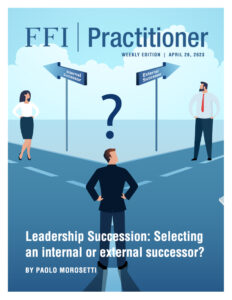
View this edition in our enhanced digital edition format with supporting visual insight and information.
This week, Paolo Morosetti explores the complexities involved in the process of selecting the successor in a family enterprise and shares an approach to help your clients answer the fundamental question of whether to select an internal or external successor.
Puig, a Spanish private group, is currently led by a third-generation family member. Amplifon, an Italian-listed group transitioning from the second to the third generation, has entrusted its leadership to a non-family CEO.
Both companies have navigated at least one successful generational change, and their two different leadership choices recall well-known empirical evidence: no absolute best leadership model exists for family enterprises. Often, enterprising families reach the most effective solution by evaluating the characteristics and challenges faced by the company, as well as the ownership structure and possible adjustments to it.
Selecting a successor requires a certain level of competence that arises primarily from relevant experience. Impulsive decision-making increases the risk of making mistakes that could jeopardize the family business system’s sustainability. Family enterprise advisors can help to guide their clients through the process of selecting the best leader for their companies by ensuring a rigorous process is followed that incorporates the aspects addressed in this article.
Motivation
Several primary motivations often drive multigenerational family enterprises to choose a new company leader. For example, as the current leader approaches retirement age, identifying a successor and managing the ensuing transition becomes increasingly crucial. A leader’s health concerns or a decision to retire early may force the selection of a new leader earlier than expected. An incumbent leader’s resignation or unavailability to renew the mandate may motivate the selection of a new leader. Lastly, the owners’ and board’s dissatisfaction with a current leader’s performance could also trigger the beginning of the process to select a new leader.
Guiding a Selection Committee
It is rarely an optimal choice to leave the succession decisions to one person. When a family business has already undergone a process of professionalization, it can become even more beneficial to delegate the successor selection to a board committee. Independent advisors can also help to support the selection committee’s process. In a privately owned family business, influential shareholders, who are not otherwise involved in business or in governance, may wish to have some involvement through the committee to voice their opinion.
To ensure that the selection committee works effectively, advisors should help guide their clients though managing any perceived or real conflicts of interest throughout the process. This is particularly important when committee members’ secondary interests may be prioritized over their primary interests and influence committee member judgment. These secondary interests may arise from the committee members’ family or professional ties to certain candidates. It is important to keep the primary focus on making the best choice for the unique interests of the business.
Many selection committees make decisions through seeking consensus, or even unanimity. An effective chair plays the crucial role of providing support and direction to the committee’s work, understanding the sensitivity of the decision-making process and the importance of how the final decision is communicated to the newly selected leader and the other candidates.
The Selection Process
Building on lessons learned from the most successful selection processes I’ve experienced, the selection process can be divided into three steps.
Step One: Identifying Leadership Requirements
The first step is to define the leadership requirements. This process involves describing the successor’s ideal profile, including the necessary qualities and competencies to be effective in the role. The profile often includes two variables: “must-have” and “nice-to-have” qualities.
To define the leadership requirements, the company’s unique context must be considered. Some organizations need a leader to help guide the company through a corporate restructuring, while others require a more creative leadership style to motivate the organization to experiment with new ideas without fear of failure. Some organizations may be looking to change their internationalization strategies, while others could be aiming to diversify or rethink how they are leveraging technological transformations.
The leadership profiles required for each of these situations can vary, and each deserves detailed analysis and attention. In family businesses, the ideal leadership profile should also include a set of qualities and competencies necessary to interact effectively with the family owners. Because multigenerational family ownership is dynamic and not static, the successor should also be able to help the family navigate ownership transitions and integrate the next-generation owners.
Internal candidates—those already employed within the business—may be inherently advantaged in meeting the leadership requirements due to their existing ties and knowledge of the family’s unique ownership characteristics. However, during an ownership transition, internal candidates may no longer represent the best option for maintaining ownership cohesion if the incoming owners are looking to take the company in a new direction.
Step Two: Assessment and Selection
The second step in an effective selection process is to objectively assess the candidates and, ultimately, select a successor. The selection process may be susceptible to hurried and miscalculated decisions, biases, and distortions that can favor internal candidates over external ones. The selection committee chair should work to counteract these effects.
For example, the chair can request an independent assessment to avoid rhetoric about an internal successor’s best qualities, which are often only assumed or attributed due to dynastic reasons. Internal candidates could even be assessed against external candidates to better evaluate their strengths and weaknesses. This exercise is always helpful in identifying the internal candidates’ training and development needs prior to assuming a leadership role. Ultimately, recognizing that internal candidates may have the potential to succeed but may not be ready for leadership is another significant achievement of a well-structured and increasingly professional selection process.
Step Three: Adjusting the Governance System
The third and final step of the selection process is to reconsider and adjust the current governance system as necessary. Governance is often under-evaluated or considered a separate issue, independent of a successor’s selection—however, every leadership change requires adjustments so that designated successors can best express their potential. For instance, a company transitioning from a founder to the next leader may benefit greatly from implementing a board that is capable of active oversight and risk management. Once a board is established and can delegate authority and powers to a successor, he or she can set a new tone at the top levels of management within the organization.
Choosing an External Successor
In some cases, family policies and rules may preclude family candidates from aspiring to leadership positions. When owners make the choice to be “governing owners” or “investing owners” rather than “operating owners,” they are generally driven by three main motivations. First, some families do not put internal candidates forward to avoid possibly pitting shareholders against each other who might favor different family members as succession candidates. Second, some families do not want to relive difficult succession crises of past generations—for example, when confidence in family leaders waned and they were asked to step down, straining family relationships. Finally, a family enterprise may favor an external successor to lead a business transition or a corporate restructuring phase, preventing a family member from emotionally driven, ill-considered decision making.
Conclusion: Practical Implications for Advisors
- No absolute best leadership model exists.
- Delegate selection to a committee composed of board members, which can be supported by independent advisors in the assessments of qualities and competencies of candidates.
- Divide the selection process into three steps: identifying leadership requirements, assessment and selection, and adjusting the governance system.
- When deciding whether internal candidates should be given priority in the selection process, be mindful of biases that may stem from the transgenerational orientation embedded in the family business system, as these biases can negatively impact the decision-making process.
About the Contributor

Paolo Morosetti, FFI Fellow, is a senior lecturer at Bocconi University in Milan, Italy, where he teaches corporate strategy and strategic management of family businesses. He advises family business around the world, focusing on generational transitions, family and business governance, strategy, and next generation leadership development. A board member for several multi-business and multi-national firms, Paolo is a co-author of the book Corporate Strategy for a Sustainable Growth (2020). He can be reached at paolo.morosetti@unibocconi.it.

View this edition in our enhanced digital edition format with supporting visual insight and information.





